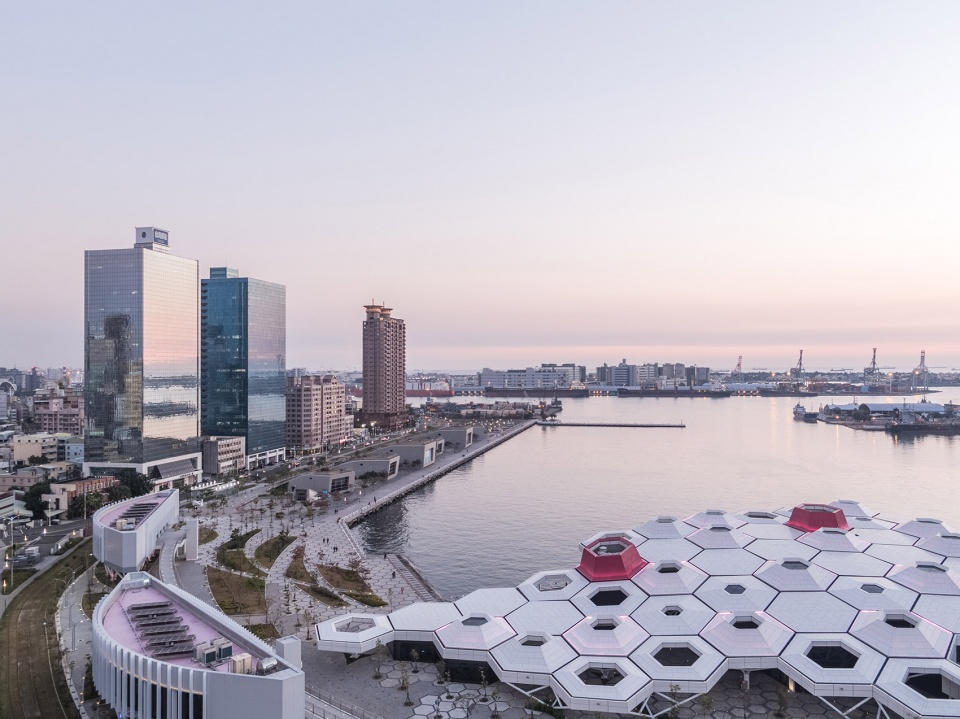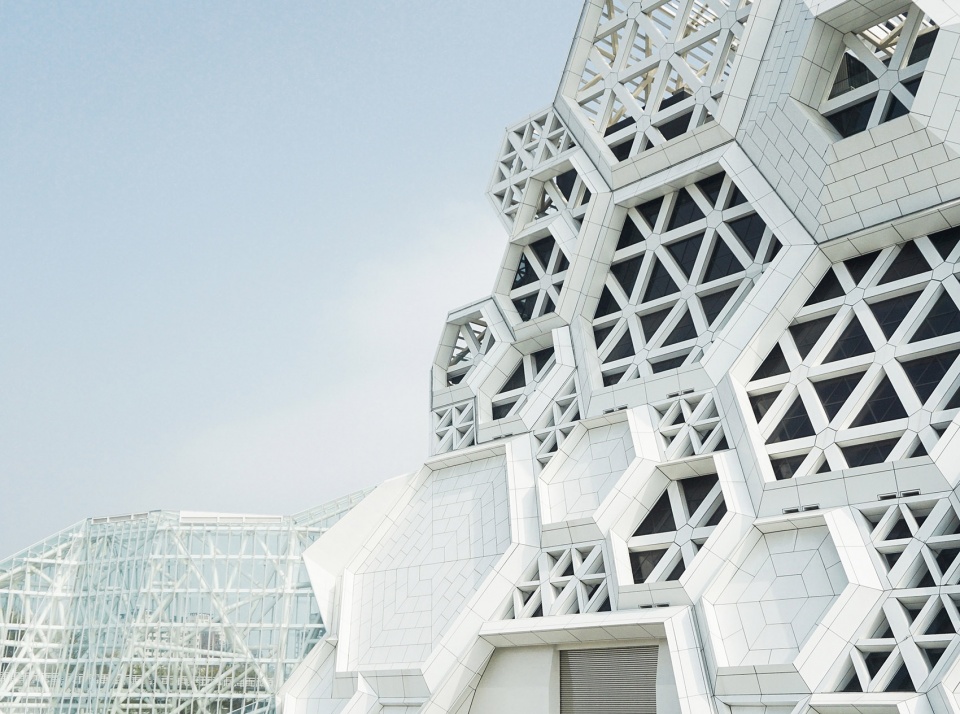

项目位于台湾南部港口城市高雄,毗邻爱河入海口。在这块特殊的宝地,水是台湾人生活的中心:经济上拥有台湾最大的港口,城市上有爱河为城市的两边划出分界线,环境上相对湿度在60% 到 80% 之间——流行音乐中心规划了一个从海底脱水而出的几何型景观。由泡沫、珊瑚、海藻、波浪和水生动物组成的外观,用于特定用途。每件作品都充分展现了其外形和内涵,同时融合成一个共同的生态系统。
▼音乐厅和塔楼外观,external view of the music hall and the towers ©Tai tzu chun

Next to the mouth of the Love River, the project is located in the port city of Kaohsiung, in southern Taiwan. In this particular enclave where water is the central axis of Taiwanese life -both economically with the largest port in Taiwan, and at the urban level with the Love River drawing a dividing line between the two parts of the city, and at the environmental level where the relative humidity ranges between 60% and 80% – the Pop Music Center proposes a landscape of geometries rescued from the seabed. Foams, corals, seaweed, waves and aquatic animals are arranged on the surface and specialize in specific uses, so each piece manifests its own personality and a formal challenge and, at the same time, is integrated into a common ecosystem.
▼项目鸟瞰,aerial view of the project ©YI-HSIEN LEE


高雄流行音乐中心的建筑生态系统由以下部分组成:
1. 音浪塔,设有可容纳12000人的室外礼堂、可容纳3500人的音乐厅和两座带有办公项目、博物馆和排练室的塔楼。
2. 鲸鱼堤岸,包含六个用于活动、音乐会或演示的现场表演厅。
3. 海豚步道,由一条走道连接的五家餐厅。
4. 珊瑚礁群,一个展览中心和户外多功能区。
5. 以及一系列公园和步道,连接整个项目。
The architectural ecosystem that make up The Kaohsiung Pop Music Center are,
▼功能分析图,program analysis ©Manuel Monteserín

整个建筑群的设计与规划相呼应,但也允许在没有音乐会时进行自主活动。因此建筑不仅能容纳内部空间,同时转向外部,产生了不同的集会空间。
The entire complex is designed to respond to the program, but also to allow spontaneous activities to take place when there are no concerts. In this way, the architectural pieces accommodate the interior rooms and, at the same time, turn onto the exterior generating different meeting spaces.
▼近景鸟瞰,内外结合的不同集会空间,closer aerial view, various gathering spaces in and out ©YI-HSIEN LEE


音浪塔:高雄的两座礼堂和塔楼
The GREAT WAVE. Two auditoriums and two towers in Kaohsiung
音浪塔由两个大礼堂组成,一个是可容纳 12,000 人的露天礼堂,另一个室内礼堂可容纳 3,500 人,另外还有分别位于两个礼堂顶部的两座塔楼。
The GREAT WAVE consists of two large auditoriums -one open-air with a capacity of 12,000 people and the other covered for 3,500 people – and two towers which top each of the auditoriums respectively.
▼音浪塔外观,external view of The GREAT WAVE ©YI-HSIEN LEE

露天礼堂坐落在绿色的地幔上。观众席散布在绿地区域,以小的地形起伏适应不同表演和人群,成为一个灵活的空间。较小的塔楼则避免了外界对舞台的干扰。室内礼堂作为最高点有一个较大的基座。它的外表面以六边形几何形状进行折叠,并与地面分离,使观众可以进入建筑物内部。大堂空间位于六边形表面和音乐厅之间。音乐厅有五个独立的看台。与大厅相连。以形成礼堂屋顶的六边形网格的设计,继续作为主塔的立面。
The outdoor auditorium is set on a green mantle. The spectators are distributed throughout the green area, which becomes, with small topographical gestures, the most flexible space adapted to the different shows and groups of people. The smaller tower houses the stage and closes the intervention. The covered auditorium functions as the great plinth on which the tallest tower emerges. Its outer skin folds through the hexagonal geometry and is detached from the ground allowing access to the building. The lobby space is between the outer skin and the concert hall. The concert hall, on the other hand, opens up like a fan with five separate bleacher blocks. Between them is the connection with the lobby. The design of the hexagonal grid that forms the roof of the auditorium continues drawing the facade of the main tower.
▼室内礼堂基座,covered auditorium as the great plinth ©IAN CHOI

▼鸟瞰基座,aerial view of the plinth ©YI-HSIEN LEE

▼折叠的立面,folded facade ©YI-HSIEN LEE

▼立面细部,details of the facade ©Chiung-Yao TSENG

▼大厅,hall ©Kano Chang

两座塔楼是高雄流行音乐中心最具标志性的元素。他们分割了音乐空间:排练室、办公室、展览等。每个空间都分别从一个礼堂中出现:高塔为音乐厅提供了连续性,露天塔则作为开放的空中礼堂。塔楼最初是分开设计的,但为保护相邻的住宅区免受声学影响,它们最终被背对背放置,塔楼之间形成一个裂缝,成为入口中庭。这些塔是城市天际线的一部分,在任何视角都十分引人注目,将游客引向港口,就像一座巨大的灯塔。
The two towers are the most iconic element of the Kaohsiung Pop Music Center. They distribute the spaces dedicated to the music industry: rehearsal rooms, offices, exhibitions, etc. Each one emerges respectively from one of the auditoriums: the highest one gives continuity to the Concert Hall while the smaller one serves as a backdrop for the open-air auditorium. The towers were initially conceived separately, but their position had to be rethought to protect the adjoining residential areas from the acoustic impact. Finally, they were placed back to back, creating a crack between them as a large access atrium. These towers are part of the city skyline and can be easily recognized from any point, leading the visitor to the port, like a great lighthouse.
▼塔楼,城市天际线的一部分
towers becoming part of the city skyline ©Chen Hung

▼从街道看向音乐厅和塔楼
view to the auditorium and the tower from the street ©YI-HSIEN LEE

▼连续的塔楼和音乐厅,the auditorium continued with the tower ©Kano Chang

六边形的表皮除了在水平的观众厅屋顶和塔楼立面之间建立连续性,还实现了建筑尺度认知的转换。由于建筑的测量模数并非由三米高的楼层决定,因此人们很难通过裸眼以及与其邻接的建筑判断它的尺寸。它如同一位天外来客,在五光十色的城市街区之中小露头角。
The hexagonal geometry skin, in addition to allowing continuity between the horizontal plane of the auditorium roof and the tower’s façade plane, achieves a change of perception in the scale of the building. It is difficult to measure it with the naked eye in relation to the other buildings in the immediate surroundings because its measurement parameters are not determined by floors separated by three meters. It is a being from another planet peeking between the prismatic blocks of the city.
▼六边形表皮在音乐厅和塔楼之间建立连续性
hexagonal geometry skin creating continuity between the auditorium and the tower ©YI-HSIEN LEE


▼表皮细部,details of the skin ©CHIEN MING CHEN


鲸鱼堤岸:高雄的Live House
WHALES. Live Houses in Kaohsiung
Live Houses 或“鲸鱼”是一系列用于俯瞰大海的空间,可以组织活动、音乐会或演出。它们在整个建筑群中第一批(2017 年)完工。共有六个体块,两个较大(XL),两个中等(M)和两个较小(S),它们通过地下室的一个大型停车场相连。
The Live Houses or “whales”, are a series of spaces which overlook the sea to organize events, concerts or presentations. They were the first pieces to be completed (in 2017) of the entire complex. There are six of them, two large (XL), two medium (M) and two small (S) and they are connected by a large parking lot in the basement.
▼鲸鱼堤岸鸟瞰,aerial view of the WHALES ©YI-HSIEN LEE


Live Houses 的最大特色是它们的绿色屋顶,十分适合步行,就像鲸鱼绿色的背影出现在通往海湾的街道上,勾勒出城市的天际线,邀请路人爬上它们的背脊,观赏港口上空的落日。
The most characteristic feature of the Live Houses are their green roofs, which are also walkable. The green backs of the whales appear on the streets leading into the bay, curving the skyline of the city and inviting passers-by to climb on their backs to watch the sunset over the port.
▼Live Houses设有可上人的绿色屋顶,Live Houses with accessible green roofs ©YI-HSIEN LEE

在城市层面,鲸鱼从边缘向后退几米,以便在海边形成一条大型步行长廊。用途是多样的:虽然长廊上满是食品卡车和街头小吃摊,但在Live Houses 的甲板上,可以找到电子音乐舞蹈课程,内部可以参加视频游戏演示或爵士音乐会。
At the urban level, the whales are set back several meters from the edge to allow for a large pedestrian promenade by the sea. The uses are mixed and combined: while the promenade is filled with food trucks and street food stalls, on the decks of the Live Houses you can find electronic music dance sessions and inside, attend video game presentations or jazz concerts.
▼Live Houses边的滨海步道,promenade in front of the Live Houses ©monteserin


▼Live Houses之间的公共活动空间,public space between the Live Houses ©monteserin

▼在屋顶眺望大海,enjoy the view of the sea on the roof ©monteserin

海豚步道:高雄流行音乐中心餐厅
DOLPHINS. Kaohsiung Pop Music Center Restaurants
海豚步道与电车平行,贯穿了高雄流行音乐中心。他们是缝合被爱河隔开的两大区域的脊梁。五只海豚作为餐厅使用,他们略高于地面,行人可以自由进入周围的围栏,走到它们连接的人行天桥上,沿着步道步行,能够欣赏海湾的不同视角,通向爱河的对岸。
The Dolphins run parallel to the tram throughout the Kaohsiung Pop Music Center. They are a backbone that sews the two large areas divided by the Love River. The five Dolphins, with restaurant use, are raised on pillars leaving free access to the enclosure around the perimeter. From the footbridge which connects them, you can walk along them having a different perspective of the bay and cross to the other side of the river.
▼与电车平行的步道和餐厅体块,pedestrian bridge parallel to the tram and the restaurant volume ©YI-HSIEN LEE

▼鸟瞰步道与景观,aerial view of the pedestrian bridge and the landscape ©IAN CHOI

▼夜晚的步道与周边环境,the pedestrian bridge and its surrounding in the night ©Yu-Zhi Lin


▼步道上方夜景,night view on the pedestrian bridge ©Terry Chiang

珊瑚礁群:高雄展览馆
The CORAL (Exhibit). Kaohsiung Exhibition Center
Coral占据了高雄流行音乐中心的中心区域。他的顶棚是一系列六边形几何体,由大量支柱支撑(以弗雷·奥托的作品为参考)。 这是从最初的设计到最终阶段经历了最多修改的部分。在竞赛阶段,珊瑚礁群被提议作为一个绿色和步行的屋顶,夜市(台湾典型的街头食品和休闲市场)将被安置在其下。在没有音乐会或活动安排的日子里,这个区域将作为海湾的生活空间。比赛获奖后,政府建议建造一个大型封闭式展厅。
The Coral occupies the central area of the Kaohsiung Pop Music Center. It is a large roof made up of hexagonal umbrellas supported by branched pillars (taking Frei Otto’s as a reference). It is the piece that has undergone the most modifications from its initial design to its final phase. In the competition phase, The Coral was proposed as a green and walkable roof under which a night market (street food and leisure market typical in Taiwan) would be housed. This market would guarantee life and animation in the bay on days when there were no concerts or activities scheduled. After the competition was awarded, the government suggested to build a large enclosed and air-conditioned exhibition hall (heated spaces are very common in Taiwan due to the tropical climate).
▼珊瑚礁群鸟瞰,aerial view of The CORAL ©YI-HSIEN LEE

▼顶棚由六边形几何体组成,roof made up of hexagonal umbrellas ©YI-HSIEN LEE

▼展馆与步道的连接,connection between the exhibition pavilion and the pedestrian bridge ©YI-HSIEN LEE

▼六边形顶棚细部,details of the roof made up of hexagonal umbrellas ©YI-HSIEN LEE


最后,团队决定将屋顶作为最令人印象深刻的部分,将包含商业和展览项目的封闭空间与自发进行各种活动(街头市场、街舞、剧院等)。支柱允许极少的支撑和大跨度以及六边形模块的灵活性支柱允许极少的支撑和大跨度以及六边形模块的灵活性是生成非常通用和适应性强的设计的关键,以适应整个过程中发生的程序和表面的修改。这种适应性也将是未来适应不同计划的关键。
In the end, it was decided to keep the roof as the most effective design to combine enclosed spaces, which contain commercial and exhibition program, and shaded open spaces where, spontaneously, a great diversity of activities take place (street markets, street dances, theaters, etc.). The branched pillars which allow very few supports and large spans and the hexagonal module flexibility have been key to generate a very versatile and adaptable design to the modifications of the program and the surface that have been occurring throughout the process. This adaptability will also be key to accommodate different programs in the future.
▼有顶室外公共空间,covered outdoor public space ©YI-HSIEN LEE

▼室内展厅,interior exhibition hall ©YI-HSIEN LEE

▼支柱细部,details of the supporting columns ©YI-HSIEN LEE


公园和步道
THE PARKS AND WALKS
该项目定位是综合性城市设计,在爱河河口设有长廊和大型公园。台湾潮湿的热带气候确保该地区在几年内将拥有茂密的植被,并成为受污染影响的工业城市最重要的绿肺之一。
The project culminates in a comprehensive urban design with promenades and a large park at the mouth of the Love River. Taiwan’s humid tropical climate ensures that in a few years the area will be populated with lush vegetation and could become one of the most important lungs of an industrial city so affected by pollution.
▼整体夜景鸟瞰,overall aerial view of the project in the night ©Chen Li Hsiien

▼夜晚五彩缤纷的音乐厅建筑与城市,Concert Hall and the city with colorful illuminations ©SHUN CHEN

©Kevin Lin
©Su,Bo-An
▼音乐厅夜间照明,illumination of the Concert Hall ©上:Su,Bo-An,下:Lo Ruey-Lin


▼表演现场,performance venue ©DarrenTeng


▼生态设计分析,ecology design analysis ©Manuel Monteserín

▼总平面图,master plan ©Manuel Monteserín

▼声浪塔总平面图,site plan of The SOUND WAVES ©Manuel Monteserín

▼声浪塔一层平面图,first floor plan of The SOUND WAVES ©Manuel Monteserín

▼声浪塔剖面图,section of The SOUND WAVES ©Manuel Monteserín

▼鲸鱼堤岸总平面图,site plan of The WHALES ©Manuel Monteserín

▼鲸鱼堤岸平面图,plans of The WHALES ©Manuel Monteserín

▼鲸鱼堤岸局部平面图和剖面图,partial plan and section of The WHALES ©Manuel Monteserín

▼海豚步道平面图,plan of The DOLPHIN ©Manuel Monteserín

▼海豚步道局部平面和剖面,partial plan and section of The DOLPHIN ©Manuel Monteserín

▼珊瑚礁群平面图和剖面图,plans and sections of The CORAL ©Manuel Monteserín















